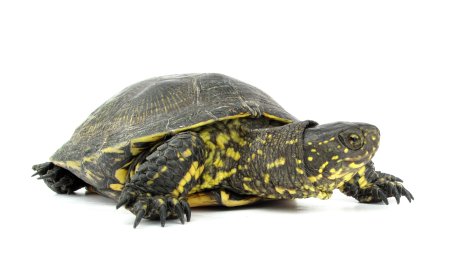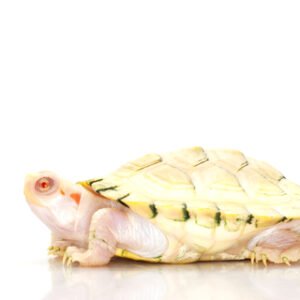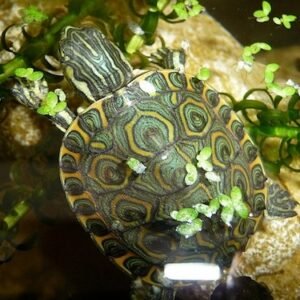Physical Characteristics and Habitat
The European pond turtle, scientifically known as Emys orbicularis, is a species characterized by its distinct physical attributes. Adult turtles typically measure between 15 to 30 centimeters in shell length, with females generally being larger than males. One of the most notable features of this turtle is its shell, which is often a dark brown or olive color, occasionally exhibiting yellow or orange spots. The smooth, oval-shaped carapace is complemented by a flattened plastron, aiding in streamlined movement through water.
The skin of the European pond turtle varies in color but often presents a greenish or brownish hue with lighter markings. Their limbs are well-adapted for swimming, equipped with webbed feet that enhance their mobility in aquatic environments. Additionally, these turtles have distinctive yellow or white stripes on their heads, which aids in species identification. The eyes are situated dorsally, providing a wide field of vision while submerged.
As for their habitat, European pond turtles predominantly inhabit freshwater environments such as ponds, marshes, and slow-moving rivers. These habitats provide the necessary conditions for feeding, breeding, and basking. Water quality plays a critical role in their survival, and the turtles thrive in areas with abundant aquatic vegetation and minimal pollution. Preferred nesting locations are often sandy or gravelly banks adjacent to these water bodies, where females lay eggs during the warmer months. They exhibit a preference for sites that ensure the safety and warmth needed for embryonic development.
Overall, the physical characteristics and preferred habitats of the European pond turtle play a crucial role in their ability to thrive within various ecosystems across Europe. The need for clean water and suitable nesting areas highlights the importance of conservation efforts aimed at preserving these adaptable reptiles.
Conservation Status and Threats
The European pond turtle (Emys orbicularis) is currently considered a species of concern due to its declining populations across various regions. According to the International Union for Conservation of Nature (IUCN), this species is classified as “Near Threatened” in many areas, reflecting a decrease in numbers largely attributed to several key threats. Primary among these is habitat destruction, which results from urban development, agricultural expansion, and infrastructure projects that disrupt their natural environments. As wetlands and shallow ponds are drained or polluted, the habitats essential for their survival become increasingly scarce.
Another significant threat to the European pond turtle is pollution, particularly from agricultural runoff containing pesticides and fertilizers. These chemicals can contaminate the water bodies where pond turtles reside, negatively impacting their health and reproductive success. Additionally, the introduction of invasive species can lead to competition for resources and predation, further threatening native turtle populations.
Climate change also poses a substantial risk, as shifting temperatures and changing precipitation patterns can alter the ecosystems where these turtles thrive. For instance, rising temperatures may affect nesting success, while extreme weather events can lead to habitat loss. Such climatic changes require urgent attention, as they threaten not only the European pond turtle but also many species that share its habitat.
In response to these pressing issues, conservation programs have emerged across Europe, focusing on habitat restoration, pollution control, and public awareness campaigns aimed at preserving this species. Initiatives such as creating protected areas and encouraging sustainable land use practices are vital for safeguarding turtle populations. Individuals can contribute to these efforts by supporting local conservation organizations, practicing environmentally friendly habits, and advocating for policies that protect aquatic habitats. Fostering a collective responsibility toward the preservation of the European pond turtle is essential for ensuring its survival for future generations.





